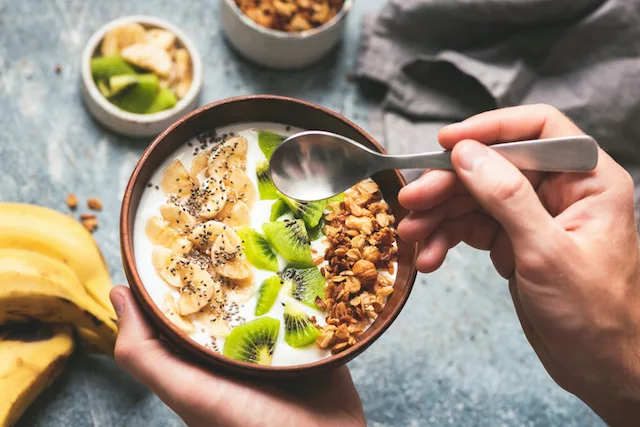Do you need both prebiotics and probiotics, or is one better to take than the other? Chelsey Amer, MS, RDN, CDN, highlights the primary differences between prebiotics vs. prebiotics, then shares why both are worth adding into your routine (and how).
These days, taking a probiotic supplement to enhance your gut health is common. Over the last decade, the popularity of probiotics has skyrocketed to new levels… and for good reason. After all, probiotics support much more than just your gut health. A diverse and healthy gut microbiome positively influences your immune system, cravings, weight, mental health, and more.
That said, you may not be as familiar with prebiotics, which are equally important. But what’s the real difference between prebiotics vs. probiotics, anyway? Keep reading to see how the two are similar yet different. Plus: how to add both into your dietary routine to support your gut and greater health.
Prebiotics vs. Probiotics: 3 key differences
1. Prebiotics Feed Probiotic Bacteria
The marked difference between probiotics and prebiotics is that probiotics are live organisms—namely bacteria and yeast—whereas prebiotics are food for probiotics.
In order for the probiotics in food and supplements to be effective, they must survive the acidic environment of the stomach and then bile secretion to make it to the colon, where bacteria colonizes the gut. Your gut is a transient environment, meaning the composition of your microbiome changes over time. It’s influenced by factors like age, diet, health status, medications, and even prebiotic consumption.
In order for prebiotics to be useful, they must also bypass the digestive process to make it to your colon, where gut bacteria live. Fiber is a non-digestible carbohydrate that survives the digestive process, which is why prebiotics are high-fiber carbohydrates. Specifically, these foods are all high in soluble fiber, which is highly fermentable.

2. They Impact Your Health in Different Ways
Trillions of live probiotic organisms, with upwards of 1,000 different bacteria strains, reside in your gut. Your overall gut flora impacts your health and can influence your risk of disease.
Probiotics can impact your health and bodily processes in a variety of ways, such as by:
- Colonizing the gut
- Producing short-chain fatty acids
- Synthesizing vitamins, including vitamin K and folate
- Reinforcing the gut barrier
- Neutralizing toxins
- Modulating the immune system
- Influencing hormones
Your overall gut composition will have a bearing on your overall health. For instance, your gut microbiome can impact your weight due to influences on nutrient absorption. Studies also demonstrate that those with high cholesterol levels may benefit from probiotic supplementation, thanks to their influence on bile salt metabolism.
On the other hand, prebiotics can influence your overall health both indirectly and directly. They can help your microbiome flourish, as well as directly impact your wellness regimen more noticeably upon consumption.
For example, inulin is a prebiotic fiber found in plants such as bananas, onions, and Jerusalem artichokes. When consumed, prebiotic fiber can help:
- You feel full for longer
- Reduce overeating
- Promote bowel regularity
Moreover, like all types of fiber, it can help lower LDL (“bad”) cholesterol levels and help balance your blood sugar.
3. Prebiotics and Probiotics are measured differently
Colony forming units measure the amount of viable probiotics (or bacteria) in a supplement. Many probiotic supplements will contain billions of CFUs. However, more CFUs does not always mean it’s more effective.
On the other hand, prebiotics are measured as grams of fiber. The FDA suggests that adults consume 25 to 35 grams of fiber daily. More specifically, 3 to 5 grams of prebiotic fiber are recommended as part of that daily intake for the greatest benefits.
Note: When viewing the nutrition facts of a food, not all fiber listed will be prebiotic fiber.
Is it better to take prebiotics or probiotics?
To cut to the chase, probiotics and prebiotics are both beneficial for optimal gut health. Since probiotics and prebiotics work synergistically to help your gut microbiota flourish, it’s key to add probiotics and prebiotics to your diet whether through foods, supplements, or both.
Eating probiotic-rich foods or taking a probiotic supplement can directly increase the amount of good bacteria in your gut. Similarly, consuming prebiotic-rich foods or taking a prebiotic supplement can boost the good bacteria in your gut by helping them thrive. Remember: Prebiotics act as fertilizer to your gut bacteria, allowing them to thrive.
In your colon, gut bacteria ferment and metabolize the prebiotics to stay alive. They have a synergistic relationship. When your gut bacteria metabolize prebiotics, they create various short chain fatty acids. These help to:
- provide the bacteria with energy
- support your immune system
- aid inflammatory processes

How to Get More Probiotics and PRebiotics in Your Routine
Now that you know the importance of adding probiotics and prebiotics to your wellness regimen, put these insights into practice by following these tips.
Integrate Probiotic Foods into Your Meals
A little goes a long way with many foods rich in probiotics. To start, you may want to integrate one probiotic food into your team each week (but it’s even better to eat a variety of them on daily basis). Within a month, you’ll have several probiotic-rich foods in your fridge, waiting to be added to your usual meals.
Here are some simple ways to include more probiotics in your meals:
- Add a generous helping of kimchi to a grain bowl
- Add a spoonful of miso to a tofu marinade
- Make Greek yogurt bowls for breakfast
- Use kefir in your smoothie
Load Up on Prebiotic Foods
Different prebiotics have different roles, so it can also be useful to vary the types of prebiotics you consume. Here are some of my go-to ways to consume the recommended 3 to 5 grams of prebiotic fiber daily:
- Garlic and onions are kitchen staples, but they also have prebiotic benefits. You can add them to nearly any dish from pastas and stir frys to sheet pan dinners.
- Leeks can be intimidating if you don’t cook often. However, you can slice and sauté them just as you would onions to get a boost of prebiotic fiber.
- Apples are rich in pectin, a type of soluble fiber that acts as a prebiotic. When digested by bacteria, pectin produces butyrate, a short chain fatty acid that helps support beneficial bacteria.
- Oats and barley are rich in beta-glucan, a type of prebiotic fiber that’s also been shown to support lower cholesterol levels.
- Asparagus are a favorite spring vegetable, but you can also find them frozen year-round.
- Dandelion greens can be added on top of avocado toast for a spicy bite.
- Jerusalem artichokes look like ginger root from the outside, but can be roasted, blended into soups, or shaved raw into salads.
- Unripe green bananas are rich in resistant starch, which offers prebiotic benefits. They won’t be as sweet as your usual yellow bananas, but you can sauté them to add more flavor.
Consider Taking Probiotic and/or Prebiotic Supplements
It takes a well-planned diet to ensure you’re eating enough probiotics and prebiotics from food. To take things to the next level to support your gut, you can take supplements that contain probiotics, prebiotics, or mix them both.
HUM offers several different probiotics tailored for different concerns:
Gut Instinct contains strains like Bifidobacterium Breve and Bifidobacterium Longum to support healthy digestion and your immune system.
Private Party uses Lactobacillus Reuteri species to help support vaginal health.
Fan Club uses strains like Lactobacillus Plantarum (DR7) to address menopause symptoms, like mood changes, by supporting the gut-brain axis.
PRO ACV is our only probiotic supplement in gummy form, which is especially beneficial if you have difficulty swallowing pills. It contains Bacillus coagulans IS-2, a type of spore-forming probiotic.
Skin Squad supports your gut and skin with strains like Bacillus Subtilis DE111 and Bifidobacterium Lactis HN019. It’s also the only HUM probiotic that contains prebiotic fiber (from konjac root) to feed the good bacteria.
Rounding out this list is Beauty zzZz Gummies. It’s made with a combination of melatonin and calming botanicals to help you fall asleep effortlessly, plus prebiotic fiber in the form of fructooligosaccharides (FOS) to help balance digestion and support regularity. This prebiotic supplement contains 2 grams of FOS, which is as much prebiotic fiber as found in three bananas.
Rotate your probiotics to vary the strains
Final tip: You may wish to rotate your probiotic supplements every few months to add different strains to your gut microbiome. With different strains playing different roles, more diversity can help support your overall health and wellness.
Build Your Supplement Routine
Take The HUM Quiz
The post Is It Better to Take Prebiotics or Probiotics? Here’s What a Dietitian Says appeared first on HUM Nutrition Blog.
---------------------------
By: Chelsey Amer
Title: Is It Better to Take Prebiotics or Probiotics? Here’s What a Dietitian Says
Sourced From: www.humnutrition.com/blog/prebiotics-vs-probiotics/
Published Date: Wed, 29 Mar 2023 01:38:36 +0000
Read More
 General Health and WellnessFitness and ExerciseSupplements and VitaminsPandemic NewsVideosPrivacy PolicyTerms And Conditions
General Health and WellnessFitness and ExerciseSupplements and VitaminsPandemic NewsVideosPrivacy PolicyTerms And Conditions
